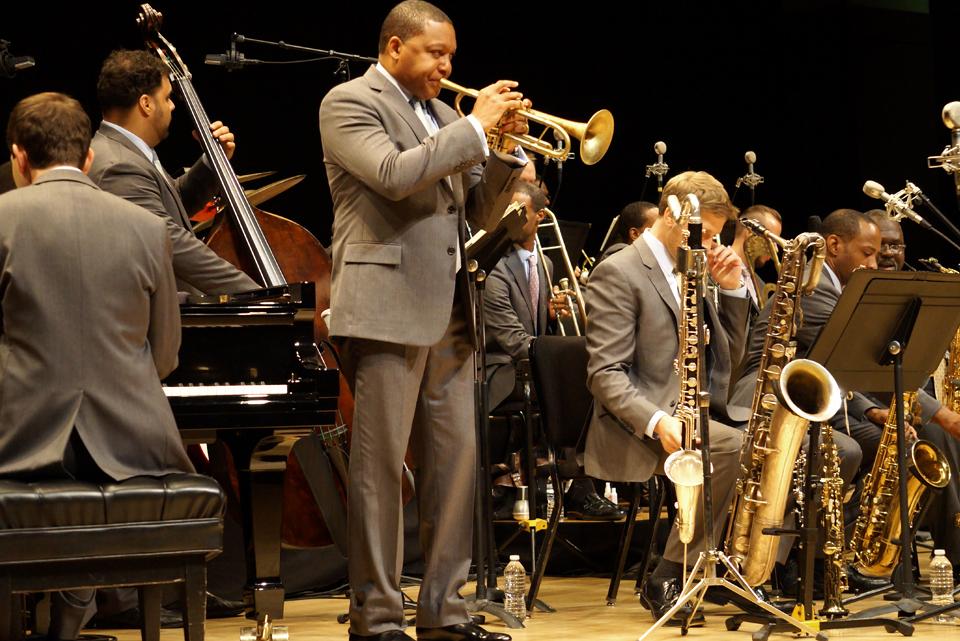By Marilyn Lester
On the three days before Duke Ellington’s April 29 birthday, Wynton Marsalis and the Jazz at Lincoln Center Orchestra (JALCO) bestowed upon its patrons a great birthday gift, the full presentation of Ellington’s historic Black, Brown and Beige (BBB) suite. And to sweeten the pot, BBB was preceded by The Best of Basie, music played by that other titan jazz orchestra of the Swing era (and beyond). Both men, Ellington and Basie, led bands of the highest standard, containing many now legendary players of the time. The same can be said of the JALCO. Rarely is this band not in the groove. They play tight, and with Marsalis at the helm, the music is set up with witty and knowledgeable introductions.
Basie’s outfit was noted for its hard swing and its All American Rhythm section, with Basie himself at the piano. (Duke’s men could swing but their book was more varied in style and tempo.) Generally, the JALCO features new arrangements of material by band members. For the Basie numbers, many original arrangements were played, such as Eddie Durham’s workings of “Every Day I Have the Blues” and “Swingin’ the Blues.” The former was sung by JALCO trombonist, Chris Crenshaw, in the style of Basie’s prime band singer of the era, Jimmy Rushing. Crenshaw, whose vocals are quite solid, also sang “Goin’ to Chicago Blues,” written by Basie and Rushing, in the style of Joe Williams, who appeared with the Count from 1954 to 1961.
The hard swing of the Basie band was demonstrated in the set opener, the hopping “Jumpin’ at the Woodside,” a Basie original composition. By contrast, when Basie reformed the orchestra in the 1950s, called the Second Testament, the arrangements were lusher, such as Wild Bill Davis’ work with “April in Paris.” Two highlights from the set were “Tickle Toe,” written by Lester Young, Basie’s now iconic tenor saxophone player and the finale number, “Blee Blop Blues,” written by Basie and A.K. Salim. “Tickle Toe” is a melodic swing based on a Bix Beiderbecke improvisation, with principals Victor Goines and Julian Lee sharply playing the body of Young’s original solos. “Blee Blop Blues” saw the JALCO play out as it entered this Basie segment – swinging, this time with a brass-heavy, energetic piece that premiered at the 1957 Newport Jazz Festival. The tune is a satire of sorts, a marriage of the old swing style with the newer groundbreaking form of Bebop.
In introducing “Black, Brown and Beige,” Marsalis once again acknowledged his love, appreciation and understanding of the immense genius of Duke Ellington. Jazz at Lincoln Center is built on “the Ellington ethic,” well illustrated in the JALCO’s performance of BBB. As Marsalis has noted, “Duke had an understanding of all the foundational elements of American music.” BBB was composed for Ellington’s 1943 debut at Carnegie Hall. Heretofore, Ellington’s compositions and best known works were Songbook standards and short numbers in several styles. BBB was the Maestro’s first long-form work, radically different from anything he’d done before. BBB was a (relatively) long and ambitious work, a suite divided into three movements, “Black,” “Brown” and “Beige,” each with three sections. Ellington described it as a “tonal parallel to the history of the American Negro.” Critics, stunned by the unexpected, savaged the work. Ellington was so affected he never played the suite again, although he did play and record sections of it. (Today, the brilliance of BBB is duly acknowledged.)
One of the most famous numbers to come out of BBB was “Come Sunday,” which appears in “Black” and which is thematically echoed in each of the other movements of BBB. The song re-appeared in the My Peoplesuite and became a mainstay of the Maestro’s series of Sacred Concerts. Choosing to forego the sung version, “Come Sunday” was instead played as an instrumental solo, sensitively and beautifully rendered by alto saxophonist, Sherman Irby. “Brown” introduced another of Ellington’s masterpieces, which also was recycled in “My People:” The Blues (Ain’t).” The tune was sung by Brianna Thomas, whose angelic voice is pitch perfect but too ethereal for the darkness of the lyric and the complex structure of the melody.
Crenshaw again took the spotlight as emcee and conductor for BBB. His abilities as the former were earnest and engaging, if not smoothly polished. But as a conductor he was in his metier. Interestingly, Ellington never conducted, leading from the piano and emceeing from a center stage mic. Similarly, Marsalis leads from his chair in the trumpet section of the band, with Victor Goines frequently acting as music director/leader from his chair in the sax section. Another highlight of BBB, brief as it was, was violinist Eli Bishop’s turn in “Black” preceding Irby’s solo on “Come Sunday.”
Top hat’s off to Wynton Marsalis and company for presenting the entirety of BBB. In 1977, a recording made at Carnegie Hall at BBB’s debut was recovered and released as an album, so the original is, thankfully, not lost to history. Still, BBB is a piece that’s rarely done and has scant been recorded. To hear it honored by the JALCO may be a history-making event in its own right.
The Jazz at Lincoln Center Orchestra: The Best of Basie and Black, Brown and Beige, Rose Theater
April 26, 27 and 28, 2018.
Jazz at Lincoln Center, 10 Columbus Circle, 212-258-9800, www.jazz.org



















